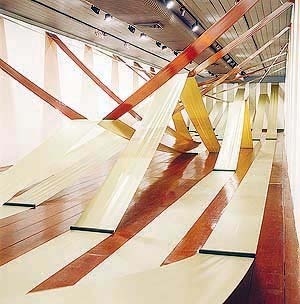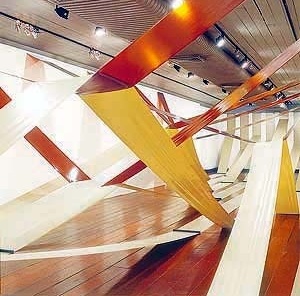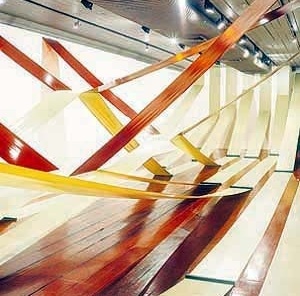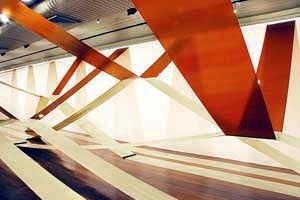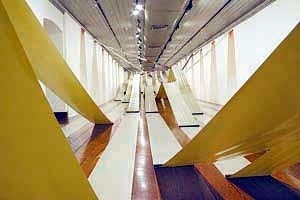Like Ana Holck’s previous installations, Elevated is rooted in art’s occurrence in the present, here and now, not there or later. Before they materialize, her installations are conjectured in the artist’s projections which draft, research, write, speak, project, calculate, assess, negotiate and rehearse. Later, they persist in the memory of whosoever has experienced them, and may also be conjured back through the vestiges of their production (the mediums in which they were recorded – drawings, models, texts, photographs and videos). However, they are truly experienced only where and when they take place.
Her installations reject the convention of the work of art as a transportable object with a virtually infinite existence. Taken to the limit, the refusal to conform movable, perennial things generates configurations which are sufficiently physical for intention and desire. In avoiding ostentatious objecthood, they also reject immateriality and steer clear of lack and overflow. To greater or lesser degrees, they depend upon the intrinsic demands of each intervention.
Ana Holck is concerned with sticking to whatever is necessary, no more, no less. A pursuit of legitimate economy that leads her to use strips of vinyl adhesive tape, an industrial product transformed into artistic material which is a distinguishing feature of her work, contributing to the (apparently endless) current expansion of artistic media. Elevated intensifies this investigation, exploring the material’s attributes (color, dimension, luminescence, tenaciousness, adherence, smoothness and viscosity), proceeding to draw strips of contextual color and width which allude to elements of location. It configures quasi non-things designed as they design the space itself, testing the adhesive’s structural ability as it begins to experiment with the strips’ adhesion among themselves, no longer merely to the architectural supports, building a network of tensions (fragility/strength, attraction/repulsion, obstruction/liberation).
Having been conceived for a specific gallery within the Paço Imperial, Elevados is not adaptable to another site. Floor, ceilings, spans, doors, windows and equipments and, above all, the empty Mestre Valentim Room itself – all are elements of the work, re-dimensioned by the sheaf of strips which the artist has added to the pre-existing situation.
A confrontation of forms, rhythms, and materialities both invites and demands bodily experience. Beyond merely gazing, one must enter, move through, transit, come and go – mobilize the body that it may flow playfully across the cat’s cradle which the artist has woven on an architectural scale, a web that beckons, instigates and possibly imprisons. An experience which calls for critical perception, Elevated requires distance for reflection, because it introjects and complicates the concomitant sensations of being simultaneously inside and outside.
By interfering in widely used places which may possess amorphous, un-stimulating conditions in addition to certain fixed, restrictive, and impeditive features, the problem which Ana Holck poses to herself is precisely their activation and re-qualification. Consequently, she must reflect on their elements and structures. Without aspiring to restore allegedly original purities, or striving for optimizations, the artist considers a given place in order to make it other, to re-invent it. In Elevated, the strips appear to be spatial fibers and nerves made visible and palpable. However, they are not the result of an anatomical dissection that proposes to exhibit the naked truth of the place. What the artist allows us to see are the nervures and fibrillations of another possible Mestre Valentim Room. Like the objects, spaces and bodies which they catch, beyond their literalness her installations criticize, project and fictionalize.
On the other hand, having already occurred in the street, in art galleries and cultural centers, Ana Holck’s installations have no determined or typical place in which to happen; they are open to the most diverse sites. Her vocation would appear to be action within the city, extensively. Blind Wall, In Transit, Rotary, Impediment, Permeation, Stays, Block, Elevated, Ground-Ceiling – titles with multiple meanings, which allude to plastic operations and situations, to elements of architecture, engineering and urbanism.
However, her installations affect more than buildings and cities. Beyond the physical conditions of the places in which she intervenes, her work involves art’s institutional situation. In order to experiment in institutions, it must experience the institutions. In Elevated, Ana Holck has the challenge of activating one of the galleries of the Paço Imperial, of revisiting its institutionalization. For twenty years, event after event, this space has been available to the most diverse manipulations of artists, curators, scenographers and designers, all of whom produced varied arrangements of works of art, objects, texts, colors and textures. As it changed from a submissive, empty space to an exponential one, it has been corroborated as a place rich with memories and history spanning more than two decades, though it has also become depleted, albeit still potent and filled with possibility.
Linked to the constructivist branch of modern art, her installations seek more plastic principles than form. Euclidean geometry persists, albeit not as a logical paradigm for the post-industrial world. It derives adumbratively from the places in which the artist intervenes. As language, it is based less on lexical than on syntactical qualities – on relationships, play, and movement.
Elevated is composed of strips regularly distributed from the upper limits of the walls in an orthogonal arrangement which privileges the dominant directions of the room’s cubage by confronting it in order to subvert the room’s problematic longitude. The transversal strips travel down from the ceiling, grazing, gathering up or sticking to others that slide down the walls, coming loose on their way to the floor and undulating – whether descending or ascending, the strips mutually support one another and take over the space. As they articulate themselves in a rational, intuitive arrangement, they weave a pierced, de-centered, asymmetrical web in opposition to the initially regular orthogonality, attacking the void without ever becoming formally condensed.
Without concealing the elements of the equation woven by Elevated, and by handling them with rigor and imagination, Ana Holck proposes to keep moving ahead with them, to move beyond them. She would breathe life into the Mestre Valentim Room, into the Paço Imperial and into the city. By raising horizons, she sets up a mass-less relief, an aerial topography, a destabilizing, disturbing landscape that would pull the ground away from underneath us and make us feel – ever so briefly – here, now – elevated
about the author
Professor de história da arte e da arquitetura na UERJ e no Curso de Especialização em História da Arte e Arquitetura no Brasil da Puc-Rio, autor de Vital Brazil, Cosac & Naify, 2001 e co-autor de A Missão Francesa, Sextante, 2003.



